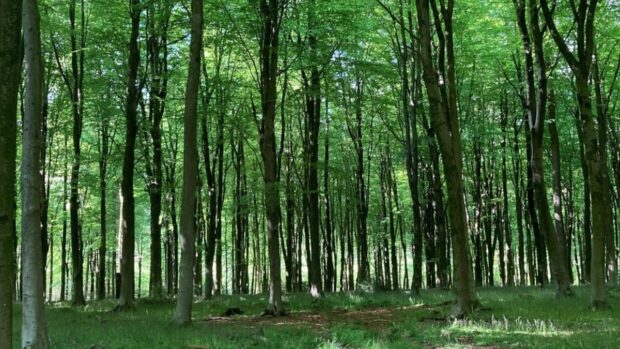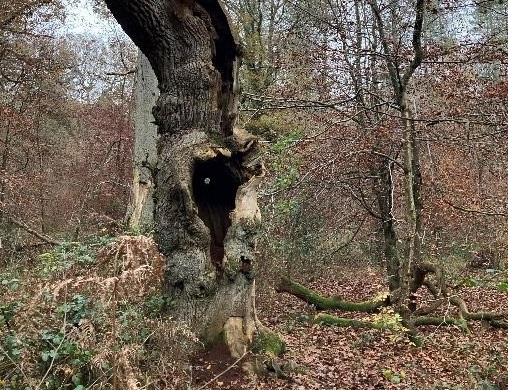 Chris Watson is a Woodland Resilience Advisor for the Forestry Commission. In this blog post he’ll be exploring the different threats facing our woodlands, and how woodland management can help mitigate these threats and increase the future health and resilience of our woodlands.
Chris Watson is a Woodland Resilience Advisor for the Forestry Commission. In this blog post he’ll be exploring the different threats facing our woodlands, and how woodland management can help mitigate these threats and increase the future health and resilience of our woodlands.
England’s woodlands are one of our most important natural assets. Vital for biodiversity and nature recovery, they also provide valuable ecosystem services such as delivering sustainable wood products, capturing carbon, helping to regulate the flow of water through our landscapes, and creating the perfect place for recreation and access to nature. However, for England’s woodlands to flourish, it’s up to us to ensure they are nurtured and in good condition. In this blog I’ll be exploring the different threats facing our woodlands, and how woodland management can help ensure good future health and resilience.
Threats to woodland biodiversity
Over past decades we have seen a decline in the condition of our woodlands and an associated decline in woodland biodiversity. Our woodlands can lack a diversity of structure, often not providing the vital deadwood and open spaces woodland wildlife depends upon. Dark, closed canopy woodlands can suppress the woodland understory and ground flora which prevents natural regeneration – integral to ensuring the next generation of hardy and resilient trees. Deer and other mammals can have a severe negative impact on ground flora found throughout our woodlands, and in many cases, browsing mammal damage is the biggest challenge to ensuring healthy, regenerating and biodiverse woodlands.

The impact of invasive species, pests, and diseases on our woodlands
The presence of pests and invasive species such as grey squirrels and rhododendron can have a negative impact on the condition of our woodlands. Grey squirrels strip the bark on broadleaved trees, severely damaging them so they are more susceptible to disease, and they can make trees grown for timber useless. Rhododendron suppresses native plants and can host diseases such as Phytophthora ramorum, which can infect and kill trees. With international trade and changing climate conditions, it is likely that we will see an increase in threats from pests, diseases and invasive species in the future.
How climate change is putting pressure on our woodlands
The environment in which our woodlands and trees grow is changing rapidly. Climate change is happening at such a rate that it is difficult for trees to adapt to changing climatic conditions in rainfall and temperature. This may result in unsuitable growing conditions for some species on certain soil types, and specific climate conditions found across different parts of the country. Climate change also increases the chance of severe weather events such as storms, droughts and wildfire, which can put extra pressure on our woodlands.
The need for woodland management
The good news is that there is plenty we can do to make our woodlands more resilient to these threats. A well informed and planned approach to managing your woodland allows you to identify the main threats while considering what objectives you would like to prioritise – such as timber production, supporting biodiversity or recreation. From this, you can develop a course of action which best supports your woodland objectives in the face of the threats posed, and ensures your woodland continues to deliver those all-important ecosystem services.
Three types of woodland management activity to consider:
For most woodlands, there are some relatively simple areas to consider which will have a significant benefit to their overall resilience:
- Regeneration: Is your woodland regenerating, either naturally or through planting? Regular cycles of regeneration within a woodland allow the next generation of trees to adapt to changing climate conditions and develop their own resistance to pests and diseases. Planting trees provides the opportunity to add different species sourced from different geographical areas, which may also be better suited to your site’s future climate conditions. For most woodlands, you’re likely to need a plan to protect regeneration from browsing deer and other mammals.
- Diversity: Does your woodland have a good diversity of species and structure? A lack of species diversity can put your woodland at significant risk from pests and diseases, such as ash dieback. Having a good mix of tree species can reduce the impact of a pest or disease outbreak. A greater, more diverse structure which includes a variety of tree ages and heights, with some open space and woodland edge habitats, is also really beneficial for biodiversity. Thinning and regular cycles of tree felling and regeneration are great ways to achieve structural diversity.
- Pests and diseases: Do you know if your woodland has any pests, diseases, or invasive species present? As already discussed, the presence of pests and diseases can have a negative impact on the condition of your woodland. Often, one of the quickest ways to improve your woodland is through the safe control and removal of pests and diseases.

In addition to these general considerations for woodland management, we can also tweak our management to improve the delivery of specific benefits which best fit our objectives, for example:
Managing woodland for biodiversity gain:
- Consider maintaining or creating open space and edge habitats through a network of rides and glades.
- Control the impact of browsing mammals to ground vegetation through managing local deer populations.
- Encourage and develop future veteran trees whilst protecting any existing veteran or ancient trees.
- Coppice and fell small areas of trees to encourage structural diversity.
- Leave deadwood in your woodland to support and encourage more biodiversity

Managing woodland for timber:
- Regular thinning can improve the quality and growth of individual trees whilst generating a regular income to help fund your woodland management activity.
- Early respacing of young trees to improve stem form and to increase their growth rate can also promote resilience to strong winds.
- Improving infrastructure through roads and turning areas can make harvesting timber more efficient and help protect soils.
Create a woodland management plan
The best way to get your thoughts together, and to develop the most appropriate plan for your woodland, is by creating a woodland management plan. The Forestry Commission has a template you can follow, which ensures your woodland management activity meets the UK Forestry Standard – enabling you to apply for future felling licences and financial support. If you have any questions about how to start the process, speak to your local Forestry Commission Woodland Officer who will be only too happy to help.
Find more information on how to manage your woodland and view our helpful collection of Woodland Management Matters resources.


